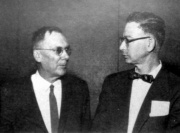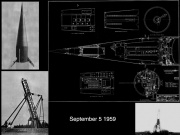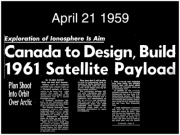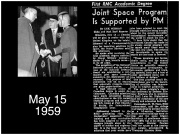The Empire Strikes Out - Canada's Defence & The Commonwealth Space Program - Part 3 by Robert Godwin
From The Space Library
Contents |
The 50th Anniversary of Aviation in the Commonwealth
Just three days after the termination of the Avro Arrow interceptor program James C. Floyd, chief engineer for the cancelled aircraft, was scheduled to speak in Montreal at a Canadian Aeronautical Institute conference. The event was to celebrate the 50th anniversary of flight in the Commonwealth. Floyd was supposed to chair the Space Flight session where he would introduce Hugh Dryden (Deputy Administrator of the brand-new American National Aeronautics and Space Agency) who had come to Canada to explain the workings of the American space program. Dryden was considered to be one of the world's top aeronautics experts, and in 1954 he had chaired a hearing between the Canadian National Research Council (NRC) and the management of A.V. Roe. The NRC had questioned Avro's performance predictions for the Arrow and had been quietly put in their place by Dryden who stated that Floyd's numbers were probably conservative and that as far as he was concerned the Avro team had no peers anywhere in the world. Not surprisingly Floyd didn't appear at the dinner in Montreal due to the chaos back at Avro, a sad irony almost certainly not lost on Dryden.
With Floyd unavailable the position of host fell to Dr Herbert Ribner.[1] Born in 1913 in Washington Ribner had been an acclaimed aerodynamicist at the National Advisory Committee for Aeronautics before moving to Canada and taking a position at the University of Toronto.[2] Dryden had been Ribner's boss at the NACA all through the late 1940s.
Ribner shared the chairmanship of the Canadian Aeronautical Institute's Astronautics Division with David Bogdanoff, a fellow American from Michigan who was head of the rocket research arm of Canadair and had played a major role in the Velvet Glove program. At the event Dryden made a dazzling presentation of American space assets showing the enormous array of projects in progress at that time.[3]
Solid Fuel Rocket Interceptors
The very next day Canada's largest rocket program began. The first firing of the new Canadian propellant took place on February 24th 1959 at the CARDE facility in Valcartier Quebec. The burn would output 20,000 pounds of thrust for 20 seconds, which was about 25% better than the standard Skylark.[4] Black Brant would be launched for the first time seven months later, on September 5th 1959, at the USAF-operated Churchill Rocket Range facility in Manitoba Canada.
Despite its military origins and funding Black Brant would never become an interceptor.[5] That role had already been assigned to the Bomarc-B and other similar large U.S. ground-based interceptors. Black Brant's military origins would be completely obfuscated in the years ahead, but there can be little doubt that the case-bound fuel for Black Brant, at the very least, was designed for a fast-response military interceptor.[6] Conveniently it was also superb for chasing fast moving aurora.
The notion that a ground-based interceptor would be an efficient method for shooting down an incoming missile had been challenged by James Floyd at a meeting of the Avro Ten-Year club in December 1957.
One of the main arguments in favour of keeping the manned interceptor was put forth, perhaps not too surprisingly, by James Floyd. He quite correctly pointed out that the state of the art of surface to air missiles in 1959 stood absolutely no chance of intercepting an ICBM re-entering at Mach 10. But an air-to-air, nuclear-armed, missile already had an 11 mile head-start in altitude and 1500 mph in speed. Floyd's argument was supported in an eloquent editorial in "Aircraft" magazine in January 1958. The editor went on to say that the replacing of aircraft with missiles was a ridiculous assumption that was an obsession in Canada the UK and the USA that was "widespread and blinding".
"A vivid example of how the character of the mission of a military aircraft can change is to be found in the case of what has until now been known simply as a "fighter". Recently, beginning with the widespread introduction into operational service of aircraft equipped to carry out automatic interceptions, more and more the designation "fighter" is being abandoned in favour of "bomber destroyer", as being more descriptive of what the aircraft is intended to do.
"Now a lineal descendant of the "fighter", the Avro Arrow, is being seriously promoted as having a capability extending from bomber destroying through to anti-ICBM operations. This does not imply anything so far-fetched as ICBM interception by an aircraft. The anti-ICBM potential would be fulfilled as a carrier for an anti-ICBM missile."
Floyd's exact words at the meeting of the Avro Ten-Year club in December 1957 were, "During the next four or five years, the biggest threat against this continent will be the manned bomber. The most potent weapon against this at the present time is the Arrow. If you think about it for a minute the normal launching platforms for anti-missiles are stationary. The Russians can find out where they are and destroy them. We have also done a quick calculation on an ICBM coming in at Mach 10 at 200 miles above the Earth's surface. An anti-ICBM missile of only one-third the thrust is needed (if it is fired from an aircraft moving at Mach 1.5 at 60,000 feet) than would be needed to carry the same size warhead to this given point in approximately the same time if it was launched from the ground. There is then a distinct advantage in launching an anti-ICBM missile from a CF-105."[7]
"Buy American"
The same day of the engine test at CARDE, and just four days after the Arrow cancellation, the Canadian government revealed to the Globe and Mail newspaper that they were now negotiating with the United States to remove the tariffs from the sale of Canadian military hardware. Three months later the "Buy American" tariffs were removed. None of the reports even mentioned whether this might have made a difference to Pearkes, who had ostensibly been trying to sell the Arrow south of the border.
An American Alliance
Two weeks after his encounter with Hugh Dryden, the CAI published an editorial by Dr. Ribner in which he argued that although the idea of a Commonwealth joint space venture was attractive, the fact that Canada's defence policy had just done an about-face, suggested to him that the Commonwealth couldn't afford its own space program. He then went on to propose that all of the work done south of the border, helping to prepare the Avro Arrow, demonstrated the practical convenience of an alliance with the United States. (U.S. wind tunnels had helped prepare the aircraft for flight and many small components were also off-the-shelf items of U.S. manufacture.) His conclusion was that if precautions were taken, Canada could still maintain a "degree of autonomy" working within the U.S. space program.[8]
Meanwhile, David Bogdanoff had been bringing top engineers up from the United States to speak to the Canadian aerospace elite since at least the previous November. Bogdanoff's position as head of rocket research at Canadair gave him unique access to the many engineers building the Atlas missile at Convair. Both companies were owned by General Dynamics of New York. On April 7th Bogdanoff hosted H.F. Dunholter, Convair’s assistant chief engineer on the Atlas rocket; who spoke to the CAI in Montreal. The next day Dunholter went on to speak to the Ottawa chapter. Less than a week later Charles Stark Draper from MIT came to speak in Toronto about inertial guidance.[9] In this respect Ribner's remark about the convenience of geography was certainly proving true. It was a lot easier for Canadians to hear first-hand from the Americans than it was from the British.
The Brain Drain
Unknown to some of the players involved at that moment the cancellation of the biggest defence project in Canada was about to play a role in effectively ending the large British interests in Canada. Over 650 companies had been supplying parts for the Arrow,[10] and it was considered a shining example of the power of the Commonwealth to produce world-beating technology. Despite this the Canadian government had turned its back on Avro. The principal reason given was that aircraft interceptors and bombers would soon be made obsolete because of missiles.
Decades of building up a Canadian aerospace brain trust would be undone within seven months. The union estimated that over 1500 engineers moved to the United States and 1000 returned to Britain.[11] Three weeks after the cancellation of the Arrow the head of NASA's Space Task Group, Robert Gilruth, arrived in Toronto to interview the top Avro engineers. He hired at least 32 of them. Just three weeks after that, NASA announced that they had accepted a proposal to build and launch a Canadian satellite.[12] Canada would contribute four receiving stations.[13]
Surprisingly the Canadian Aeronautical Institute's journal, which was published in Ottawa and was by far the largest and most important journal of its kind in Canada, barely even mentioned the cancellation of the Arrow. It would not be until September before the journal would spare a mere 240 words for the story: 86 of those words were quoted directly from Diefenbaker's speech. Every month the journal had regular reports from the different regional CAI chapters, but after March, the reports from Toronto just disappeared, as though there had never been an aerospace industry in the country's largest city. Avro's misfortune would almost certainly have been seen as a godsend for Canadair, which had deep roots inside the CAI.
On March 26th 1959 the chief of the Air Staff for the Royal Canadian Air Force, Hugh Campbell, sent a memorandum to General Pearkes explaining that there were two choices for disposing of the Arrow and its engines. 1) Declare them surplus or 2) Release them to Department of Defence Production for reduction to scrap. Campbell's recommendation was the latter to avoid the embarrassment of the aircraft being "used as a road side stand".
A Canadian Space Program
On the heels of the turbulent fallout from the Avro decision Prime Minister Diefenbaker was anxious to take any modest piece of good news to the streets, and at a speech on May 15th at Kingston Military College he spoke about the proposed Canadian satellite and said he would establish a permanent joint committee on space research in order to co-ordinate the overall Canadian space program.
"I believe that Canada should maintain its status as a scientifically advanced nation, and continue a sound programme of research into outer space." John D. Diefenbaker Kingston May 1959
Even though the United States was now in the running to launch Canada's space program Diefenbaker still expressed interest in discussing a Commonwealth space program with the British and went on to say that Canada was developing its own high altitude rocket which would be "highly efficient as a research instrument."[14] He was referring to the Black Brant which would prove to be an excellent sounding rocket but at its best, many years later, was never able to place a satellite into orbit. However, Albert Fia, a Canadian graduate of the Westcott facility in England, and Vice President of Bristol Canada, frequently stated that with a modest investment Black Brant could have put a small payload into orbit.
As early as 1958 it was known that Bristol Aerospace in Winnipeg (at that time a subsidiary of Bristol in England) would be involved in the development of Canada’s sounding rocket. Initially Bristol contributed to the project as a private venture but they requested a contract from CARDE to further develop the rocket and by the summer of 1961 Albert Fia had announced plans to create the Black Brant III, IV, V and beyond.[15] Under his guidance the Black Brant family would go on to become one of the most successful rockets ever built and would be used by NASA for decades while simultaneously cutting deeply into the market for Britain's Skylark.
However, by the time Black Brant had evolved enough to become operational, the pendulum had already begun to swing back again in favour of aircraft as an integral part of the nation’s defence plan.
Scrap Arrow
At the Kingston event Diefenbaker was given an honorary degree by George Pearkes. In amongst the rhetoric and peculiar display of seeing the Prime Minister being given an award by one of his own top advisors, the fact that many of Canada's top aerodynamics and computer experts had reported for work in Langley Virginia three weeks earlier seems to have been overlooked.[16] While Diefenbaker was being handed his diploma his new Defence Minister, Raymond O'Hurley, was officially informing parliament that the world-beating Orenda Iroquois jet engine, designed for the Arrow, was being destroyed and that the government had ordered the aircraft scrapped after the program was dropped.[17] In his memoirs Diefenbaker later stated "I was even reviled for having ordered the completed Arrow prototypes reduced to scrap when I had no knowledge whatsoever of this action." Possible interpretations of this statement are limited.
Blue Streak for the Commonwealth
Meanwhile, the British rocket scientists had been telling potential clients, including Canada, that Blue Streak could be used for satellite launches if it were equipped with the smaller missile being developed by Saunders-Roe, the Black Knight, as a second stage. This configuration could place a payload of half a ton in a 300 mile orbit.[18] A modified Black Knight could have doubled that capacity.[19]
Armed with this information, two little-known rocket scientists, Charles Erentz and Robert Mawdsey-Jones embarked on an eight-month-long campaign in many newspapers and magazines explaining why Canada should become part of a Commonwealth space program. One of the plans they proposed was to establish a space launching site at Moosonee a small town at the southernmost tip of James Bay in Northern Ontario. A communications centre would be built at Lake Hazen on Ellesmere Island. A "fleet" of forty 1000-pound satellites launched by Blue Streak into 600 mile-high polar orbits would provide a weather, navigation and reconnaissance system. The total cost predicted for the hardware would be $125M with Canada's share a modest $25M. Another $50M would be spent on the Ellesmere facility. It was anticipated that with Canada's long experience in communications that much of the electronics work would be undertaken in Montreal, making up for the many jobs recently lost with the cancellation of the Sparrow missile.[20]
Go to Chapter
Footnotes
- ^ Canadian Aeronautical Journal Apr 1959.
- ^ Graduate of Cal Tech, NACA alumni, Professor at the University of Toronto and Chairman of the Canadian Aeronautical Institute's Astronautics section
- ^ Recent Trends in Aeronautics and Space Research in the United States - Hugh Dryden - CAI Journal October 1959
- ^ Globe and Mail Feb 25 1959
- ^ Ottawa Citizen Jan 25 1960
- ^ Globe and Mail Jan 25 1960
- ^ Aircraft Jan 1958
- ^ Canadian Aeronautical Journal Mar 1959
- ^ Canadian Aeronautical Journal Sept 1959
- ^ Flight Oct 11 1957
- ^ Globe and Mail Aug 13 1959
- ^ Globe and Mail Apr 21 1959
- ^ Canadian Aeronautical Journal March 1960
- ^ Flight May 1959
- ^ Flight Aug 10 1961
- ^ Globe and Mail May 16 1959
- ^ Toronto Star May 15 1959
- ^ De Havilland Gazette Dec 1959
- ^ Flight Aug 5 1960
- ^ Toronto Star Jun 12 1959




